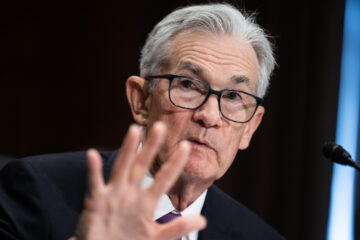Stocks pared gains Wednesday after the Fed essentially confirmed that near-term rate hikes would be followed by a reduction of its $9 trillion balance sheet.
Updated at 3:01 pm EST
The Federal Reserve made no changes to its key lending rate Wednesday, unanimously voting to hold it at a record low, but said it will be “appropriate” to begin rate hikes soon.
The Fed also kept the pace of its bond buying program, which is currently snapping up $60 billion each month following a taper of purchases in both November and December, unchanged, but said the program — which began during the peak of the pandemic in the spring of 2020 — will come to a conclusion in March.
Interestingly, the Fed also published a ‘statement of principals’ that noted it could begin the reduction of its nearly $9 trillion balance sheet after rate hikes commence, a move that muted the impact of the dovish Fed decision.
Fed Chairman Jerome Powell, in fact, said the balance sheet is “substantially larger than it needs to be”, and confirmed that its reduction would come alongside rate hikes while speaking to the media in his regular press briefing.
“With inflation well above 2% and a strong labor market, the Committee expects it will soon be appropriate to raise the target range for the federal funds rate. The Committee decided to continue to reduce the monthly pace of its net asset purchases, bringing them to an end in early March,” the Fed said in its official statement. “The Committee would be prepared to adjust the stance of monetary policy as appropriate if risks emerge that could impede the attainment of the Committee’s goals.”
“The Committee’s assessments will take into account a wide range of information, including readings on public health, labor market conditions, inflation pressures and inflation expectations, and financial and international developments,” the Fed added.
U.S. equities pared earlier gains following the Fed statemen, with the Dow Jones Industrial Average marked 75 points lower on the session, while the S&P 500 was marked 14 points higher from last night’s close.
The U.S. dollar index, which tracks the greenback against a basket of six global currencies, was marked 0.445% higher, but close to a two-and-a-half year low of 96.379, while benchmark 10-year Treasury note yields edged higher to trade at 1.851%.
Prior to the Fed statement, the CME Group’s FedWatch tool was pricing in an 88.4% chance of a March rate hike, with a near 50% chance of a follow-on move at the next meeting in May.
Still, slowing growth, rising geopolitical tensions and the lingering impact of the Covid pandemic on corporate profits could keep the central bank from acting on its inflation fighting strategy.
TheStreet Recommends: Greenflation Investing Opportunities In 2022
Greenflation Investing Opportunities In 2022 (TV-G; 3:19)
“Indicators of economic activity and employment have continued to strengthen. The sectors most adversely affected by the pandemic have improved in recent months but are being affected by the recent sharp rise in COVID-19 cases,” the Fed said. “Job gains have been solid in recent months, and the unemployment rate has declined substantially. Supply and demand imbalances related to the pandemic and the reopening of the economy have continued to contribute to elevated levels of inflation.”
The Atlanta Fed’s GDPNow forecasting model, a real-time benchmark for domestic growth, suggests the U.S. economy is growing at a healthy 6.5% clip, although PMI data from earlier this week showed activity was paced just over the 50-point threshold that separates growth from contraction.
TheStreet Recommends: What Going Green Means for Companies and Investors
What Going Green Means for Companies and Investors (TV-G; 4:13)


